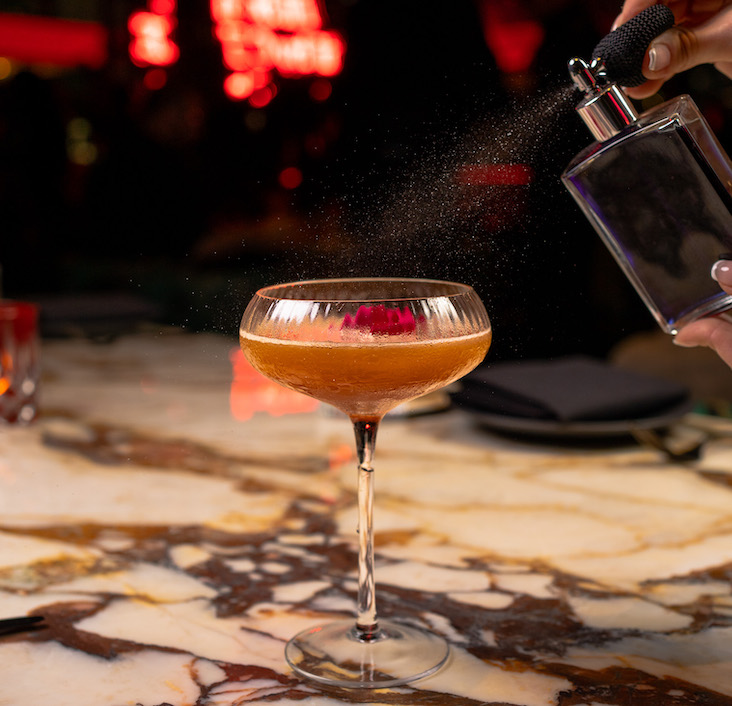If you’ve ever worked behind a bar on a busy shift, then you already know that there isn’t any such thing as a perfectly designed bar. Ill-devised layouts and poorly placed equipment often leave bartenders incapable of performing their duties behind the bar in an efficient and profitable manner.
“I think one explanation for poorly functioning bars is that operators are sometimes forced to make compromises between accommodating concept and operational needs,” suggests Steve Goumas, owner of the Rula Bula Irish Pub in Tempe, AZ. “It typically results in a great looking bar that operates nightly in chaos. The design changes might work on paper, but the ramifications they have on productivity may end up causing lost sales for the life of the business.”
Poor bar design frequently results in delayed service, which also negatively impacts sales, customer satisfaction and labor costs, if one bartender is not able to work the bar alone. Conversely, erring too heavily on the side of function to the detriment of concept is equally harmful and may undermine the long-term viability of the business. Designing a highly efficient bar requires the input of an experienced bartender, says Rob Marchant, head bartender at the Cheshire Inn in St. Louis, MO. “Would you want someone who has never piloted a plane to design a cockpit? Equipment and bartending stations are best designed for optimal output by someone who has worked in the environment. If only a few seconds are saved per round of drinks prepared and served, the difference in annual revenue is staggering.”
“While architects are highly intelligent people, I suspect that none of them have ever actually worked behind a bar,” says Barney Confrey, operating partner with Fleming’s Prime Steakhouse and Wine Bar. “It makes sense to design a bar with input from the person who spends the bulk of his time using the space and understands how it needs to function and knows the likes and dislikes of the guests.”
ENABLING HUMAN CONNECTION
Stewart Slocum, director of beverage marketing, research and development for T.G.I.Friday’s, knows all about the impact bar design can have on bartender efficiency. He also appreciates that there are other factors to consider. “To build a great bar, you need to focus on more than just productivity. People frequent bars for very human reasons–to celebrate, to meet, to console and to congratulate. The bar design should go beyond efficiency such that it enables these key human connections.”
Designing a bar involves determining the specific size and shape of the physical bar structure and the precise layout of the equipment. The optimum design allows bartenders to work at peak efficiency, servers to receive their drink orders quickly, and most importantly, for patrons to fully enjoy the bar’s products and ambiance. All of these must work in synergy if the operation is to perform at its highest level of profitability and remain within concept.
There are a number of factors that affect the physical shape of the bar, not the least of which is the area in which the bar is to be situated. Popular shapes include linear bar, L-shaped, horseshoe and oval or island bar and each has merits.
WHICH STYLE WORKS BEST?
“Ask a room full of bartenders about which style bar is best to work and you’ll get a huge array of enthusiastic responses,” says Slocum. “The responses are likely going to be based on the type of concept that they are currently working. A linear design may work great for a wine bar in Soho, but a disaster for a crowded bar on Sixth Street in Austin. The shape of the bar should be determined by the way that the patrons will use it.”
The linear bar is undoubtedly the easiest shape for bartenders to work efficiently. It allows for unobstructed views of the patrons seated at the bar and can often be worked by only one bartender. The design is also the easiest of the various shapes in which to position equipment, outfit with workstations and properly merchandise inventory. It often requires less square footage to generate the same volume of business and to accommodate the same number of bar stools as other shaped bars.
“Linear bars are unfortunately the least interesting and appealing shape from a design standpoint,” says Tracy Finklang, director of beverage operations at Rock Bottom Restaurants. “Working an exceptionally long bar, where to get from one end to the other requires marathon type-endurance, also poses its own unique challenges.”
The L-shaped bar is widely used because it’s relatively easy to incorporate in most floor plans and to outfit with equipment and workstations. It can also be worked effectively by only one bartender. The L-shape design does at times obstruct the bartender’s line of vision. A bartender standing at one end of the bar often cannot see patrons seated at the other end, which may lead to delayed service.
According to Fleming’s Confrey, “Any bar design that requires the bartender to keep his or her back to the guests for any length of time is flawed.” Thomas Burnham, who has built three bars in the Florida Keys and still tends bar days at the Casa Marina Wyndham Resort in Key West, wholeheartedly agrees. “The real problem with horseshoe or oval bars is that the bartender always has his back to two-thirds of the customers at any one time. That’s inherently bad for business.”
“In my experience, the island bars are definitely the hardest to work,” states Cheshire Inn’s Marchant. “The bartender spends much of the shift running in circles.” Horseshoe and oval bars require constant movement on the bartender’s part to ensure that all the patrons seated at the bar receive proper service. These bars are also the most labor-intensive, requiring more bartenders to work during hours of peak business to provide the same level of service.
AVOID OVER-BUYING EQUIPMENT
Slocum says one of the costliest mistakes operators make is to restrict the operation by over-purchasing equipment. “Like any growing entity, bars need to evolve over time and require flexibility. It’s not fair to guests–whose needs change quickly–to limit your bar with cumbersome equipment. For example, if you purchase five frozen drink machines, you better be prepared to feature five high appeal, high return specialty drinks from here to eternity.”
Goumas stresses that outfitting a facility with a narrow bar top is a critical mistake. “Considering how popular eating at the bar has become, many operators don’t have bar tops with the width necessary to adequately serve food. Bar tops less than 24 inches wide can’t accommodate all that’s required to present menu items properly. That’s an example of how poor design can needlessly reduce revenue.”
Goumas also recommends making room behind the bar for menus, silverware, napkins, plates, water glasses, assorted condiments and a bus tub for dirty items. This will allow the bartenders to professionally serve the guests eating food at the bar. It’s a simple modification that will likely bolster sales.
Another specification to be aware of is the distance between the back bar and any piece of front bar equipment. If there is less than 30 to 36 inches, the bartenders will be cramped and have difficulty moving. If the distance is greater than three feet, the bartenders will be constantly wasting time traveling between the workstation and the back bar.
“Sufficient working space behind the bar is crucial,” says Confrey. “I’ve tended bars with some very big guys and despite them being graceful as gazelles, crossing their path in tight quarters was an operational disaster. Nightly we get bruised, banged up and lose product through spillage.”
KEEP DISPLAY CASES HIGH
There appears to be consensus that display cases merchandising premium liquors should be located directly behind the workstations above counter-height. This allows guests to easily see the products and prevents bartenders from stooping down to retrieve them. To save on storage space, consider designing the display case shelves wide enough to accommodate bottles two deep, thereby eliminating the need for under-counter liquor storage.
Burnham points out that a critical oversight is not planning sufficient area to handle the volume of dirty glassware returned to the bar. Finklang agrees, and says, “Allowing dirty glassware to build-up is unsightly and one of the leading causes of breakage. Equally important is allowing for adequate glassware storage. Running out of clean service glassware during a rush is really unacceptable.”
While the ideally designed bar may not exist, flexibility can often overcome any inherent shortcomings.
“Gone are the days when concepts can get away asking patrons to wait three-deep for a drink,” says Slocum. “In the nation’s hotbeds of nightlife, like South Beach, FL, the Meatpacking District in NY and Deep Ellum in Dallas, we’re seeing older bars add beer tubs, or Cosmo and Martini stations to better accommodate guests on the weekends. You don’t have to let your physical plant dictate what you can or can’t do.”
Robert Plotkin is the past president of the National Bar & Restaurant Association and author of numerous books including Successful Beverage Management- Proven Strategies for the On-Premise Operator.
Station Masters
Bartending at a high-volume bar is a highly choreographed art; one that depends on properly designed workstations. Nearly everything a bartender needs to fill any drink order should be positioned within a six-foot radius of the station, which realistically translates to a step and a reach. The ice bin is the focal point of the bartender’s workstation. The balance of the equipment and supplies should be positioned around the station to create an effective use of space so that drink orders can be made with a minimum of wasted motion. Wasted motion equates to lost sales.
“One fundamental design flaw is to situate the service stations far away from the bar top action,” says Tracy Finklang of Rock Bottom Restaurants. “Workstations should always be facing out to the bar top so that the bartenders can see what’s going on.”
The experts agree that the design of the workstation is also vitally important. The items used most frequently should be placed closest to the ice bin, minimizing the amount of time it takes the bartender to reach them. Since most bartenders are right-handed, mixing equipment and supplies should be positioned such that there’s a minimum of cross-handed movements required making drinks.
For example, to maximize efficiency glasses should be stored to the left of the workstation, allowing bartenders to pick-up glassware with their left hands while adding the ice with the right. Likewise, a hand sink is ideally positioned to the right of the workstation, allowing the bartender to dump the excess contents from his or her mixing equipment, blender or returned glasses with a minimum of movement.
“Even how the pour mat is positioned makes a fractional difference,” says Steve Goumas of Rula Bula Pub, Tempe, AZ. “If a jigger is used, it should be placed on the pour mat to the left. This allows the bartender to use it in the left hand while holding a bottle with the right. It’s the same reason the soda gun should be mounted on the right side of the ice bin so that the bartender is capable of using it without reaching across his body.”
Regardless of the actual shape of the bar facility, the bartender workstations should be positioned so that there is an equal distance between them, reducing the amount of distance and time necessary for a bartender to reach a workstation to make a drink order. If there are two workstations at a linear bar, for example, the stations should be positioned five or six feet from each end. If there are three stations, the third station should be located in the middle of the bar, providing easy access to all bartenders. –RP




